There are many different cooking fat options, and most of us use these fats and oils for cooking our food from time to time.
Choosing the right option and using it in sensible amounts is important, as we can compromise the benefits of different foods if we use excessive amounts of added fat.
This article lists 25 common cooking fats and oils alongside nutritional values showing their calorie and fat content.
The source of all nutritional data is the USDA’s FoodData Central Database.
Table of contents
- 1) Avocado Oil
- 2) Butter
- 3) Canola (Rapeseed Oil)
- 4) Cocoa Butter
- 5) Coconut Oil
- 6) Corn Oil
- 7) Cottonseed Oil
- 8) Extra Virgin Olive Oil
- 9) Ghee
- 10) Goose Fat
- 11) Grapeseed Oil
- 12) Lard
- 13) Macadamia Nut Oil
- 14) Margarine
- 15) Palm Kernel Oil
- 16) Peanut Oil
- 17) Red Palm Oil
- 18) Refined Olive Oil
- 19) Rice Bran Oil
- 20) Safflower Oil
- 21) Sesame Oil
- 22) Soybean Oil
- 23) Sunflower Oil
- 24) Tallow (Beef Dripping)
- 25) Vegetable Shortening
- Which Is the “Best” Cooking Oil?
1) Avocado Oil
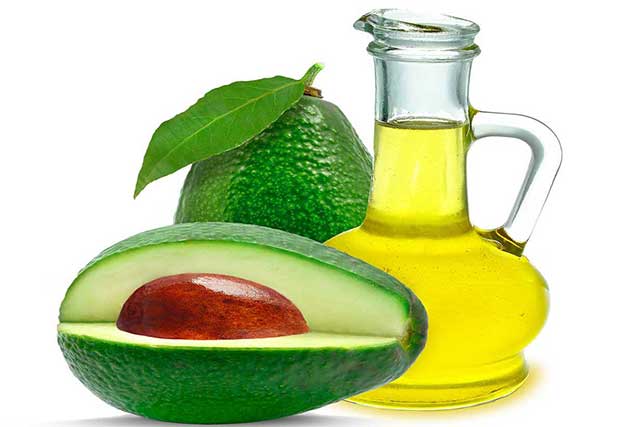
Avocado oil has only recently been widely available in stores.
Like olive oil, it is high in a monounsaturated fatty acid called oleic acid.
Here is the nutrition profile for avocado oil per 14-gram tablespoon serving (1):
| Name | Amount |
|---|---|
| Calories | 124 kcal |
| Carbohydrates | 0 g |
| Fat | 14.0 g |
| Saturated fat | 1.62 g |
| Monounsaturated fat | 9.88 g |
| Polyunsaturated fat | 1.89 g |
| Omega-3 fatty acids | 0.134 g |
| Omega-6 fatty acids | 1.75 g |
| Protein | 0 g |
Fatty Acid Ratios
- Saturated fat: 12.1%
- Monounsaturated fat: 73.8%
- Polyunsaturated fat: 14.1%
Pros & Cons
- Avocado oil is predominantly a source of monounsaturated fat, with small amounts of saturated and polyunsaturated fatty acids.
- The oil has a smoke point above 250°C (482°F) (2).
- Avocado oil has a relatively mild and neutral flavor, so it will not impart its flavor on food like stronger-flavored coconut and extra virgin olive oils can.
- Although the price has fallen over the past few years, avocado oil is often more expensive than other cooking oils.
Find out more about avocado oil here
2) Butter
Butter is arguably the tastiest cooking fat.
However, taste and nutrition are separate topics, so is butter a good choice?
The nutritional values for a 14.2-gram tablespoon of butter are as follows (3):
| Name | Amount |
|---|---|
| Calories | 102 kcal |
| Carbohydrates | 0.009 g |
| Fat | 11.5 g |
| Saturated fat | 7.17 g |
| Monounsaturated fat | 3.32 g |
| Polyunsaturated fat | 0.43 g |
| Omega-3 fatty acids | 0.04 g |
| Omega-6 fatty acids | 0.31 g |
| Protein | 0.12 g |
Fatty Acid Ratios
- Saturated fat: 65.7%
- Monounsaturated fat: 30.4%
- Polyunsaturated fat: 3.9%
Pros & Cons
- Butter is popular for its taste and lends great flavor to foods like curries and baked goods.
- Butter contains lactose and casein (milk sugars and proteins), which can burn with exposure to high heat.
- Since butter still contains (minimal amounts of) lactose, it could cause issues for people with severe lactose intolerance (4).
- Butter is high in saturated fat. Studies demonstrate that moderate butter intake can increase LDL cholesterol (LDL-C) levels, with high LDL-C being associated with increased cardiovascular risk (5, 6, 7).
- A tablespoon of butter contains 97 mcg of vitamin A, equal to 11% of the daily value for the vitamin (3, 8).
Find out more about butter here
3) Canola (Rapeseed Oil)
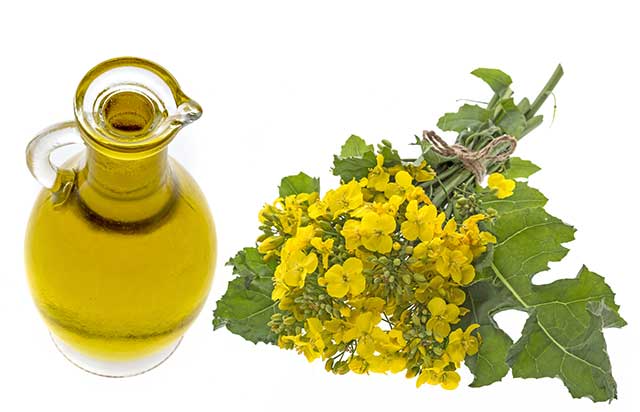
Canola, otherwise known as rapeseed oil, is primarily a source of polyunsaturated fatty acids.
Firstly, here is what a 14-gram tablespoon of Canola oil offers nutritionally (9):
| Name | Amount |
|---|---|
| Calories | 126 kcal |
| Carbohydrates | 0 g |
| Fat | 14.0 g |
| Saturated fat | 0.93 g |
| Monounsaturated fat | 8.76 g |
| Polyunsaturated fat | 3.54 g |
| Omega-3 fatty acids | 1.04 g |
| Omega-6 fatty acids | 2.49 g |
| Protein | 0 g |
Fatty Acid Ratios
- Saturated fat: 7.0%
- Monounsaturated fat: 66.2%
- Polyunsaturated fat: 26.8%
Pros & Cons
- Canola oil has a relatively high smoke point of between 220°C (428°F) and 238°C (460°F) (10, 11).
- It has a relatively low price compared to options like olive oil, avocado oil, and butter.
- Canola oil has a relatively neutral flavor.
- A tablespoon of Canola oil provides 2.42 mg of vitamin E, 16% of the daily value (8, 9).
See here for a deeper look at Canola oil
4) Cocoa Butter
It is possible to buy cocoa fat (the fatty part of the cocoa bean) and even use it in cooking.
The only problem? It’s rather expensive and doesn’t offer most people good value.
Cocoa butter is mainly a source of saturated and monounsaturated fatty acids.
Per 13.6-gram tablespoon, here are the nutritional values it offers (12):
| Name | Amount |
|---|---|
| Calories | 120 kcal |
| Carbohydrates | 0 g |
| Fat | 13.6 g |
| Saturated fat | 8.12 g |
| Monounsaturated fat | 4.47 g |
| Polyunsaturated fat | 0.41 g |
| Omega-3 fatty acids | 0.38 g |
| Omega-6 fatty acids | 0.01 g |
| Protein | 0 g |
Fatty Acid Ratios
- Saturated fat: 62.5%
- Monounsaturated fat: 34.4%
- Polyunsaturated fat: 3.1%
Pro & Cons
- Cocoa butter tastes good.
- It is very expensive, and it does not offer good value for the majority of consumers.
- Cocoa butter can be difficult to find.
- Cocoa butter contains a high amount of stearic acid. Despite being a saturated fatty acid, stearic acid has a relatively neutral impact on LDL-C. However, while cocoa butter does not significantly increase LDL-C levels, it contains palmitic acid and raises LDL more than liquid vegetable oils (13).
For more information see this guide to cocoa butter
5) Coconut Oil
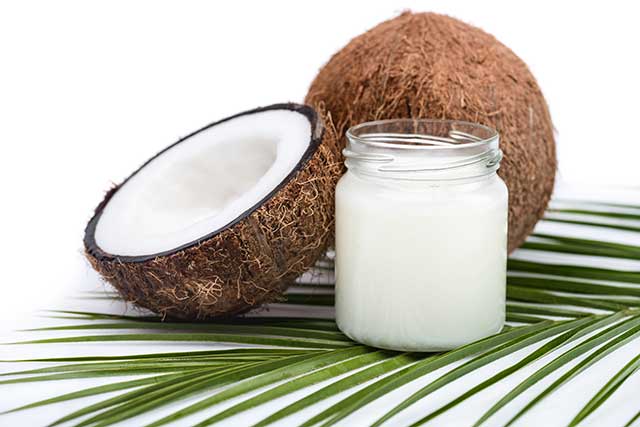
With a long history as a traditional fat in tropical regions, coconut oil has surged in popularity over the past decade or two.
Although it can sometimes leave things tasting slightly coconutty, this popular oil has some positive (and some negative) points.
First, here are coconut oil’s nutritional values per 13.6-gram tablespoon (14):
| Name | Amount |
|---|---|
| Calories | 121 kcal |
| Carbohydrates | 0 g |
| Fat | 13.5 g |
| Saturated fat | 11.2 g |
| Monounsaturated fat | 0.86 g |
| Polyunsaturated fat | 0.23 g |
| Omega-3 fatty acids | 0.003 g |
| Omega-6 fatty acids | 0.23 g |
| Protein | 0 g |
Fatty Acid Ratios
- Saturated fat: 91.1%
- Monounsaturated fat: 7.0%
- Polyunsaturated fat: 1.9%
Pros & Cons
- Studies show that coconut oil exhibits good oxidative stability when exposed to heat (15, 16).
- Coconut oil can influence the flavor of a dish, leaving a mild coconutty taste. Depending on the person and their taste preferences, this may or may not be a good thing.
- Due to its high saturated fatty acid content, coconut oil is likely to increase LDL cholesterol levels (17, 18).
- Unrefined virgin coconut oil has a smoke point of 177°C (350°F) (19).
Find out more about coconut oil here
6) Corn Oil
Also known as maize oil, corn oil comes from the maize germ. It is a type of vegetable “seed” oil.
As a seed-extracted oil, corn oil is predominantly a source of an omega-6 polyunsaturated fatty acid called linoleic acid.
Per 14-gram tablespoon, here are the nutritional values of corn oil (20):
| Name | Amount |
|---|---|
| Calories | 126 kcal |
| Carbohydrates | 0 g |
| Fat | 14.0 g |
| Saturated fat | 1.88 g |
| Monounsaturated fat | 3.88 g |
| Polyunsaturated fat | 7.41 g |
| Omega-3 fatty acids | 0.15 g |
| Omega-6 fatty acids | 7.27 g |
| Protein | 0 g |
Fatty Acid Ratios
- Saturated fat: 14.3%
- Monounsaturated fat: 29.5%
- Polyunsaturated fat: 56.2%
Pros & Cons
- Corn oil is one of the cheapest available cooking oils.
- It has a relatively high smoke point of 232°C (450°F) (21).
- Compared to coconut oil, corn oil lowers LDL-C levels in adults with elevated cholesterol (22).
- Possibly due to its high polyunsaturated fat content and lack of polyphenols, several studies show that corn oil has relatively low oxidative stability (23, 24).
- A tablespoon serving offers 3.16 mg of vitamin E, 21% of the daily value (20, 8).
7) Cottonseed Oil
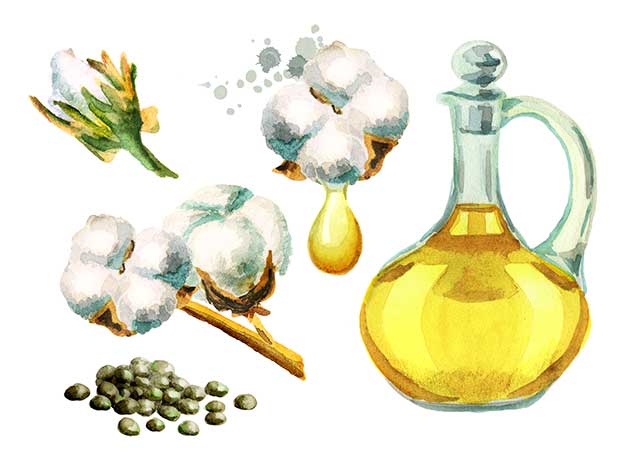
Cottonseed oil is a cooking oil with a long history, and it was the primary ingredient in partially hydrogenated (trans fat) shortening products like Crisco and Cottolene.
There is a robust scientific consensus on the harmful effects of trans fat, but how does cottonseed oil perform in its lesser-processed liquid state?
Here are the nutritional values for a 14-gram tablespoon of cottonseed oil (25):
| Name | Amount |
|---|---|
| Calories | 124 kcal |
| Carbohydrates | 0 g |
| Fat | 14.0 g |
| Saturated fat | 3.63 g |
| Monounsaturated fat | 2.49 g |
| Polyunsaturated fat | 7.27 g |
| Omega-3 fatty acids | 0.03 g |
| Omega-6 fatty acids | 7.21 g |
| Protein | 0 g |
Fatty Acid Ratios
- Saturated fat: 27.1%
- Monounsaturated fat: 18.6%
- Polyunsaturated fat: 54.3%
Pros & Cons
- Cottonseed oil is more affordable than avocado, coconut, olive, and nut oils.
- The oil has a neutral taste and doesn’t influence the flavor of foods or dishes.
- A small study showed that cottonseed oil might decrease total cholesterol without affecting HDL levels (26).
- Cottonseed oil is very high in polyunsaturated fat, which makes it less stable than oils with higher saturated or monounsaturated fat levels for long, high-temperature cooking. In one study, cottonseed oil deteriorated faster than palm oil (27).
- Cottonseed oil is a good source of vitamin E. A tablespoon serving offers 4.94 mg, which is 33% of the daily value (25, 8).
8) Extra Virgin Olive Oil
We can hear claims of extra virgin olive oil being one of the healthiest oils in the world, and it is a main ingredient of the Mediterranean diet.
However, there seems to be a common belief that olive oil is excellent for use on salads but not suitable for cooking. Is that true, or is it just a myth?
First, here are the nutrition facts for extra virgin olive oil per 14-gram tablespoon (28):
| Name | Amount |
|---|---|
| Calories | 126 kcal |
| Carbohydrates | 0 g |
| Fat | 14.0 g |
| Saturated fat | 2.17 g |
| Monounsaturated fat | 9.58 g |
| Polyunsaturated fat | 1.33 g |
| Omega-3 fatty acids | 0.09 g |
| Omega-6 fatty acids | 1.24 g |
| Protein | 0 g |
Fatty Acid Ratios
- Saturated fat: 16.6%
- Monounsaturated fat: 73.2%
- Polyunsaturated fat: 10.2%
Pros & Cons
- Extra virgin olive oil is predominantly a monounsaturated fat source and displays a reasonably high degree of oxidative resistance.
- In recent lab tests analyzing commercial cooking oils, extra virgin olive oil outperformed all other oils, including coconut oil, by containing the least amount of polar compounds after heat exposure (29).
- Extra virgin olive oil is a significant source of polyphenols, which help to protect the oil against oxidation from heat, light, and oxygen (30).
- Unfortunately, fraud has plagued the olive oil industry, and there have been numerous cases of products fraudulently claiming to be genuine extra virgin olive oil. See this guide to trustworthy olive oil brands for help finding an authentic oil.
- Extra virgin olive oil costs a bit more than most other cooking oils, so it may not be suitable for all budgets.
- A tablespoon provides 2.932 mg of vitamin E, 20% of the daily value (28, 8).
Find out more about extra virgin olive oil and its nutritional properties
9) Ghee
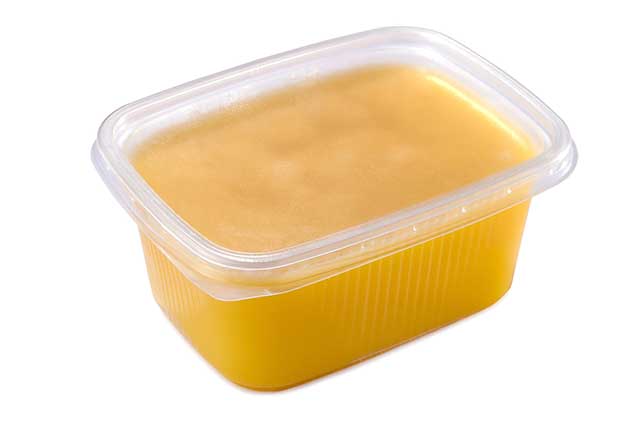
Ghee is a traditional cooking fat in India but is widely available worldwide.
Ghee is made by boiling butter to evaporate its water content; the two have similar characteristics. The only difference is that ghee doesn’t have the additional water, lactose (sugar), and casein (protein) content of butter.
Here are the nutritional values per 14-gram tablespoon of ghee (31):
| Name | Amount |
|---|---|
| Calories | 123 kcal |
| Carbohydrates | 0 g |
| Fat | 13.9 g |
| Saturated fat | 8.67 g |
| Monounsaturated fat | 4.02 g |
| Polyunsaturated fat | 0.52 g |
| Omega-3 fatty acids | 0.20 g |
| Omega-6 fatty acids | 0.32 g |
| Protein | 0.04 g |
Fatty Acid Ratios
- Saturated fat: 65.6%
- Monounsaturated fat: 30.4%
- Polyunsaturated fat: 3.9%
Pros & Cons
- Ghee does not contain lactose or casein (milk sugars and protein). As a result, ghee is a better choice than butter for individuals with milk allergies or lactose intolerance/sensitivity (32).
- Ghee has a similar fatty acid profile to butter. However, since ghee does not contain milk sugars and proteins, it will not burn as quickly at high heat.
- The main downside of ghee compared to butter is that ghee is more expensive.
- Like butter, ghee contains large amounts of a saturated fatty acid called palmitic acid. As a result, ghee is likely to increase LDL-C levels (33).
- A tablespoon of ghee provides 118 mcg of vitamin A, 13% of the daily value (31, 8).
See this guide for an overview of how ghee compares to butter and the major differences.
10) Goose Fat
Goose fat is widely considered one of the best-tasting cooking fats available. But what does it provide nutritionally?
Per 12.8-gram tablespoon, goose fat has the following nutritional values (34):
| Name | Amount |
|---|---|
| Calories | 115 kcal |
| Carbohydrates | 0 g |
| Fat | 12.8 g |
| Saturated fat | 3.55 g |
| Monounsaturated fat | 7.26 g |
| Polyunsaturated fat | 1.41 g |
| Omega-3 fatty acids | 0.06 g |
| Omega-6 fatty acids | 1.25 g |
| Protein | 0 g |
Fatty Acid Ratios
- Saturated fat: 29.0%
- Monounsaturated fat: 59.5%
- Polyunsaturated fat: 11.5%
Pros & Cons
- Goose fat is primarily a source of monounsaturated fat, similar to the main fats in olives and avocados. It contains moderate amounts of saturated fat and small amounts of polyunsaturated fat.
- Goose fat adds substantial flavor to anything you use it with.
- Depending on the location/country, goose fat can be difficult to find, and it is typically more expensive than liquid oils.
See this guide to goose fat to find out more
11) Grapeseed Oil
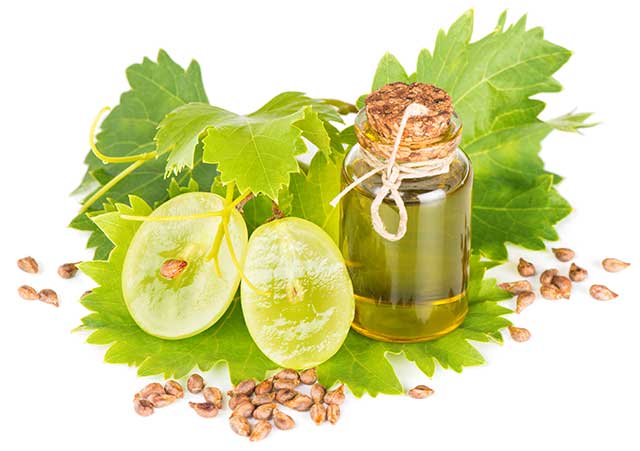
First introduced as a byproduct of the winemaking industry, producers make grapeseed oil by pressing leftover grape seeds to extract their oil.
As with most ‘seed’ vegetable oils, grapeseed is primarily a source of omega-6 polyunsaturated fatty acids.
Per 13.6-gram tablespoon, grapeseed oil has the following nutritional profile (35):
| Name | Amount |
|---|---|
| Calories | 120 kcal |
| Carbohydrates | 0 g |
| Fat | 13.6 g |
| Saturated fat | 1.31 g |
| Monounsaturated fat | 2.19 g |
| Polyunsaturated fat | 9.51 g |
| Omega-3 fatty acids | 0.01 g |
| Omega-6 fatty acids | 9.47 g |
| Protein | 0 g |
Fatty Acid Ratios
- Saturated fat: 10.1%
- Monounsaturated fat: 16.8%
- Polyunsaturated fat: 73.1%
Pros & Cons
- Grapeseed oil is reasonably affordable in comparison to more expensive oils.
- It’s a good source of vitamin E, with a tablespoon providing 3.92 mg, 26% of the daily value (35, 8).
- Due to its fatty acid profile, grapeseed oil is susceptible to oxidation at prolonged high heat temperatures. Several studies have shown that this oil can generate significant polar compounds during cooking over longer durations (14, 36).
See here for a full overview of grapeseed oil.
12) Lard
Lard is rendered pork fat, a traditional cooking fat that was once relatively common in households. However, lard declined in popularity alongside the rise in trans fats, shortening, and vegetable oils over the preceding decades.
Lard contains significant amounts of saturated and monounsaturated fat and smaller amounts of polyunsaturated fat.
A 12.8-gram tablespoon of lard provides the following nutritional values (37):
| Name | Amount |
|---|---|
| Calories | 115 kcal |
| Carbohydrates | 0 g |
| Fat | 12.8 g |
| Saturated fat | 5.02 g |
| Monounsaturated fat | 5.77 g |
| Polyunsaturated fat | 1.43 g |
| Omega-3 fatty acids | 0.13 g |
| Omega-6 fatty acids | 1.31 g |
| Protein | 0 g |
Fatty Acid Ratios
- Saturated Fat: 41.1%
- Monounsaturated Fat: 47.2%
- Polyunsaturated Fat: 11.7%
Pros & Cons
- Lard is cheaper than most cooking oils.
- It greatly affects food flavor. Lard tends to make everything taste better.
- Lard is high in saturated fat and tends to increase LDL cholesterol levels (38).
See this full guide to lard for more.
13) Macadamia Nut Oil

Macadamia nuts are predominantly a source of fat, so it makes sense that macadamia oil is now available as a cooking oil.
Per 14-gram tablespoon serving, macadamia nut oil provides (39):
| Name | Amount |
|---|---|
| Calories | 130 kcal |
| Carbohydrates | 0 g |
| Fat | 14.0 g |
| Saturated fat | 2.0 g |
| Monounsaturated fat | 11.0 g |
| Polyunsaturated fat | 0.5 g |
| Protein | 0 g |
Fatty Acid Ratios
- Saturated Fat: 14.8%
- Monounsaturated Fat: 81.5%
- Polyunsaturated Fat: 3.7%
Pros & Cons
- Macadamia oil has a mild buttery taste that adds flavor to food without overpowering it.
- The oil is primarily a source of monounsaturated fatty acids, with a smaller amount of saturated fat and minimal polyunsaturated fat.
- Macadamia nut oil offers good oxidative stability. In one study testing the oxidative stability of culinary oil, macadamia oil outperformed all the other oils (grapeseed, rice bran, avocado, and walnut oils) (40).
- Macadamia oil also contains a range of polyphenols, which may help to preserve the oil (41).
- On the downside, macadamia oil is one of the most expensive cooking fats.
See this complete guide to macadamia nut oil for more information
14) Margarine
Margarine was once thought to be a healthy replacement for butter. However, that soon changed when we found out the harms of the trans fats it contained.
In recent years, margarine no longer contains trans fats, and its nutrition properties vary depending on the specific vegetable oils used in its production.
That said, here are the general nutrition facts of a typical margarine per 14-gram tablespoon (42):
| Name | Amount |
|---|---|
| Calories | 75 kcal |
| Carbohydrates | 0.12 g |
| Fat | 8.37 g |
| Saturated fat | 1.69 g |
| Monounsaturated fat | 2.7 g |
| Polyunsaturated fat | 3.71 g |
| Omega-3 fatty acids | 0.38 g |
| Omega-6 fatty acids | 3.32 g |
| Protein | 0.02 g |
Fatty Acid Ratios
- Saturated Fat: 20.9%
- Monounsaturated Fat: 33.3%
- Polyunsaturated Fat: 45.8%
Pros & Cons
- Most people agree that margarine doesn’t taste as good as butter, and the two are used in the same way.
- Modern margarine no longer contains trans fats and comes in various blends. Some contain a small amount of butter, others contain olive oil, and some are blends of various vegetable oils.
- Margarine contains fewer calories and a lower fat (total and saturated) content than butter.
15) Palm Kernel Oil
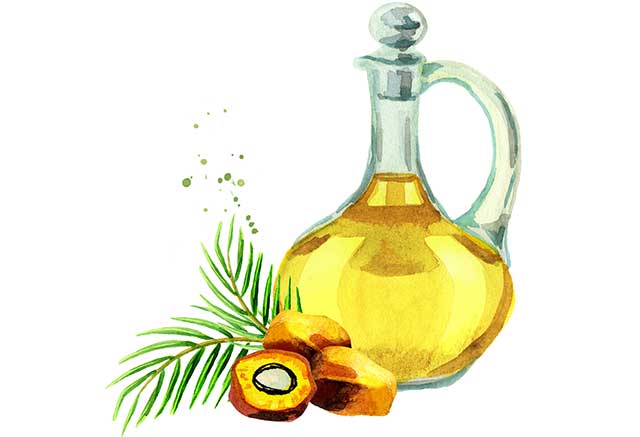
Palm oil is one of the biggest fat sources in Western (and global) diets. It is solid at room temperature, and many processed foods use this oil in their products.
Palm oil is also available to purchase as a cooking fat, sometimes packaged as ‘baking fat.’ Manufacturers produce it from the seeds within palm fruit.
Palm oil offers the following nutritional values per 13.6-gram tablespoon (43):
| Name | Amount |
|---|---|
| Calories | 117 kcal |
| Carbohydrates | 0 g |
| Fat | 13.6 g |
| Saturated fat | 11.1 g |
| Monounsaturated fat | 1.55 g |
| Polyunsaturated fat | 0.22 g |
| Omega-3 fatty acids | 0.22 g |
| Omega-6 fatty acids | 0 g |
| Protein | 0 g |
Fatty Acid Ratios
- Saturated Fat: 86.3%
- Monounsaturated Fat: 12.0%
- Polyunsaturated Fat: 1.7%
Pros & Cons
- Palm oil is cheap and readily available.
- Palm oil appears to have similar oxidative stability to high-OLEIC oils, and it offers better performance at high temperatures and long cooking durations than oils like Canola and sunflower (44).
- Palm oil is a significant source of palmitic acid, a saturated fatty acid that raises LDL-C levels (45).
- The palm oil industry is responsible for mass deforestation and threatening the habitats of animals in the tropics. ‘Certified sustainable’ palm oils might be a better ethical choice (46, 47).
16) Peanut Oil
Peanut oil is high in monounsaturated fat and has a tasty and slightly nutty flavor.
On this note, some fast food stores (like Five Guys) claim they use peanut oil because of its taste characteristics.
A 14-gram tablespoon serving of peanut oil has the following nutritional values (48):
| Name | Amount |
|---|---|
| Calories | 126 kcal |
| Carbohydrates | 0 g |
| Fat | 14.0 g |
| Saturated fat | 2.27 g |
| Monounsaturated fat | 7.99 g |
| Polyunsaturated fat | 2.79 g |
| Omega-3 fatty acids | 0.05 g |
| Omega-6 fatty acids | 2.76 g |
| Protein | 0 g |
Fatty Acid Ratios
- Saturated Fat: 17.4%
- Monounsaturated Fat: 61.2%
- Polyunsaturated Fat: 21.4%
Pros & Cons
- Peanut oil is rich in compounds that have antioxidant properties, such as tocopherols and phospholipids. Research demonstrates that these compounds help to improve peanut oil’s oxidative stability (49).
- A recent laboratory study of plant-based cooking oils found that heating peanut oil generated one of the lowest levels of oxidation products. In this extensive test, peanut oil was third to only extra virgin olive and coconut oil (14).
- Unrefined peanut oil is relatively expensive, and oils like extra virgin olive oil have more evidence for health benefits behind it.
- A tablespoon of peanut oil provides 2.18 mg of vitamin E, 19% of the daily value (48, 8).
See this full guide to peanut oil for more information.
17) Red Palm Oil
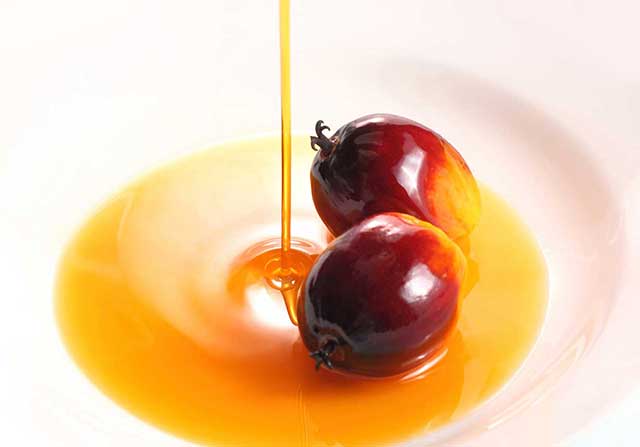
Red palm oil comes from the same fruit (palm fruit) as palm kernel oil. However, red palm oil is derived from the fruit rather than the seeds (kernel).
It is a solid fat at room temperature with an orange color and has a strong flavor.
A 15-gram tablespoon of red palm oil has the following nutritional properties (50):
| Name | Amount |
|---|---|
| Calories | 130 kcal |
| Carbohydrates | 0 g |
| Fat | 14.0 g |
| Saturated fat | 6.0 g |
| Monounsaturated fat | 6.0 g |
| Polyunsaturated fat | 1.5 g |
| Protein | 0 g |
Fatty Acid Ratios
- Saturated Fat: 44.5%
- Monounsaturated Fat: 44.5%
- Polyunsaturated Fat: 11%
Pros & Cons
- Red palm oil is full of carotenoids that give the oil its deep red color. It also contains vitamin E, and these compounds collectively give red palm oil a high level of oxidative stability (51).
- Red palm oil contains a small amount of polyunsaturated fat; it is almost 90% saturated and monounsaturated.
- One important point is that red palm oil makes food taste like red palm oil. Additionally, it gives food an orange tinge. This one could be a ‘benefit’ if someone loves the flavor or a negative if not.
- Like palm kernel oil, commercial production of red palm oil has devastated rainforests and animal habitats. A ‘certified sustainable’ scheme claims to offer a more ethical product.
For more information, see this full guide to red palm oil.
18) Refined Olive Oil
There are several different names for refined olive oil, and these may include both of the following;
- Light olive oil
- Pomace olive oil
While these oils still come from real olives, the manufacturing process is different.
Unlike extra virgin olive oil, refined olive oils use the leftover pulp after extra virgin olive oil’s extraction. Next, this pulp goes through an extraction process using solvents such as hexane (52).
Since refined olive oil still comes from olives, the fatty acid profile doesn’t significantly differ from extra virgin olive oil.
Per 15-gram tablespoon, ‘light’ olive oil provides the following nutritional values (53):
| Name | Amount |
|---|---|
| Calories | 120 kcal |
| Carbohydrates | 0 g |
| Fat | 14.0 g |
| Saturated fat | 2.0 g |
| Monounsaturated fat | 10.0 g |
| Polyunsaturated fat | 1.5 g |
| Protein | 0 g |
Fatty Acid Ratios
- Saturated fat: 14.8%
- Monounsaturated fat: 74.1%
- Polyunsaturated fat: 11.1%
Pros & Cons
- Refined olive oils offer a similar fat profile to extra virgin olive oil for a lower price.
- Refined olive oils are still relatively heat-stable owing to their minimal polyunsaturated fat content.
- The taste of refined olive oils is very “light” and neutral, whereas extra virgin olive oil has a stronger flavor. Some may prefer this lighter taste for use in their cooking.
- Heat tests on refined olive oil show they do not offer the same oxidative stability as extra virgin olive oil. This is because the refining process removes most of the beneficial polyphenols, which help to protect the fatty acids in the oil from oxidation (54).
- Olive polyphenols may potentially have some health-protective benefits, and refined olive oils barely contain any compared to extra virgin oil (55).
- Refined olive oils are much more affordable than extra virgin oil.
19) Rice Bran Oil
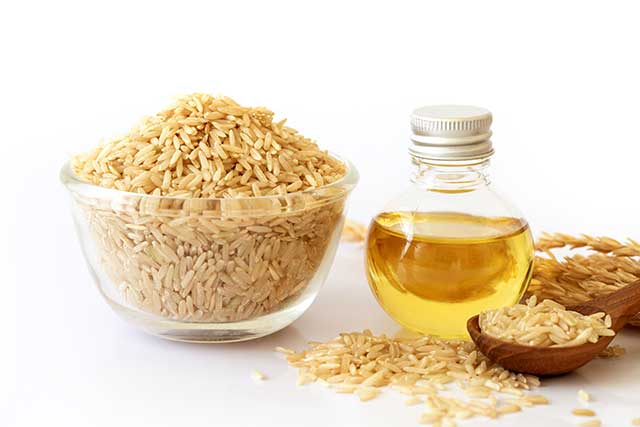
Rice bran oil comes from the outer shell of brown rice, otherwise known as the ‘chaff’ or ‘husk.’
This oil is especially popular in Japan and South Asia.
Per 13.6-gram tablespoon, rice bran oil provides the following nutrition profile (56):
| Name | Amount |
|---|---|
| Calories | 120 kcal |
| Carbohydrates | 0 g |
| Fat | 13.6 g |
| Saturated fat | 2.68 g |
| Monounsaturated fat | 5.34 g |
| Polyunsaturated fat | 4.76 g |
| Omega-3 fatty acids | 0.22 g |
| Omega-6 fatty acids | 4.54 g |
| Protein | 0 g |
Fatty Acid Ratios
- Saturated Fat: 21.0%
- Monounsaturated Fat: 41.8%
- Polyunsaturated Fat: 37.2%
Pros & Cons
- Rice bran oil is moderately high in monounsaturated and polyunsaturated fatty acids and has smaller levels of saturated fat. Despite this, it has a higher saturated fat content than most vegetable oils.
- The oil has a relatively mild flavor and isn’t overpowering when used in cooking.
- Rice bran oil appears to have higher oxidative stability than soybean oil (57).
- Rice bran oil is a rich source of vitamin E; a tablespoon provides 4.39 mg, 29% of the daily value (56, 8).
20) Safflower Oil
Safflower oil has been one of the most common oils over the past half-century and often features in food products.
This vegetable oil comes from the seeds of the safflower plant. It provides the following nutritional values per 13.6-gram tablespoon serving (58):
| Name | Amount |
|---|---|
| Calories | 120 kcal |
| Carbohydrates | 0 g |
| Fat | 13.6 g |
| Saturated fat | 0.84 g |
| Monounsaturated fat | 1.96 g |
| Polyunsaturated fat | 10.1 g |
| Omega-3 fatty acids | 0 g |
| Omega-6 fatty acids | 10.1 g |
| Protein | 0 g |
Fatty Acid Ratios
- Saturated Fat: 6.5%
- Monounsaturated Fat: 15.2%
- Polyunsaturated Fat: 78.3%
Pros & Cons
- Safflower oil is very cheap.
- Regular safflower oil is predominantly polyunsaturated fat, and studies demonstrate that it is prone to oxidation (59).
- A high OLEIC version of safflower oil is mainly monounsaturated fat. This version offers greater heat stability than regular safflower oil (60, 61).
- Safflower oil contains high levels of vitamin E; 4.64 mg per tablespoon, 31% of the daily value (58, 8).
21) Sesame Oil
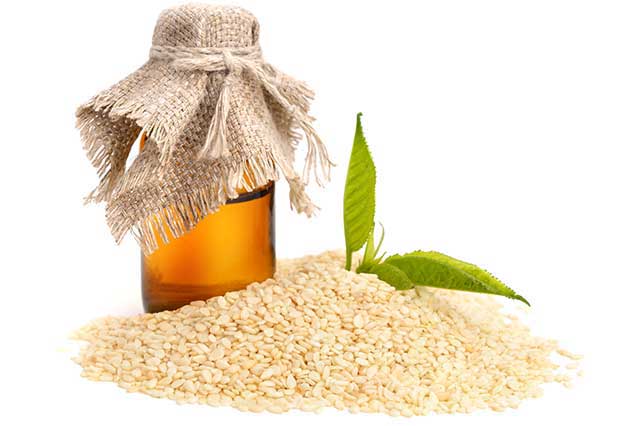
Sesame oil is an excellent choice of condiment as well as being a cooking oil. It adds flavor to food that few other oils can match.
Sesame oil provides the following nutrients per 13.6-gram tablespoon (62):
| Name | Amount |
|---|---|
| Calories | 120 kcal |
| Carbohydrates | 0 g |
| Fat | 13.6 g |
| Saturated fat | 1.93 g |
| Monounsaturated fat | 5.4 g |
| Polyunsaturated fat | 5.67 g |
| Omega-3 fatty acids | 0.04 g |
| Omega-6 fatty acids | 5.67 g |
| Protein | 0 g |
Fatty Acid Ratios
- Saturated Fat: 15%
- Monounsaturated Fat: 41.5%
- Polyunsaturated Fat: 43.5%
Pros & Cons
- Sesame oil is deep and flavorful and adds a lot of taste to dishes.
- Sesame oil has a slightly lower proportion of polyunsaturated fat than other vegetable oil choices and contains moderately high polyphenol levels. As a result, it displays somewhat better heat stability than some other refined vegetable oils (63, 64, 65).
- Adding a bit of sesame oil to a dish near the end of cooking can provide extra flavor and enhance the dish.
- Sesame oil is a bit more expensive than other vegetable oils and sells for a similar price to olive oils.
22) Soybean Oil
Soybean is one of the most common cooking oils worldwide and is hugely popular in the United States.
Here are the nutritional values per 14-gram tablespoon of soybean oil (66):
| Name | Amount |
|---|---|
| Calories | 126 kcal |
| Carbohydrates | 0 g |
| Fat | 14.0 g |
| Saturated fat | 2.09 g |
| Monounsaturated fat | 3.09 g |
| Polyunsaturated fat | 8.06 g |
| Omega-3 fatty acids | 0.93 g |
| Omega-6 fatty acids | 8.06 g |
| Protein | 0 g |
Fatty Acid Ratios
- Saturated Fat: 15.8%
- Monounsaturated Fat: 23.3%
- Polyunsaturated Fat: 60.9%
Pros & Cons
- Soybean oil contains a moderate amount of vitamin E; 1.71 mg per tablespoon, 11% of the daily value (66, 8).
- Soybean oil is one of the most affordable types of cooking oil.
- The oil has relatively low oxidative stability, and “oil blends” have higher stability than soybean oil alone (67, 68).
- A high OLEIC version of soybean is available, which offers higher oxidative stability for longer cooking times at high temperatures (69).
See this full guide to soybean oil for more information.
23) Sunflower Oil
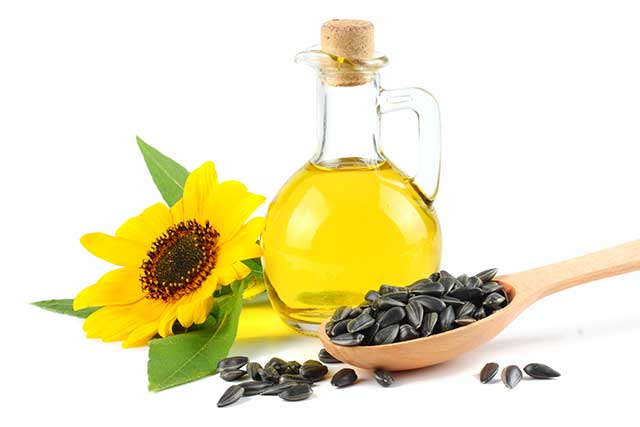
Sunflower oil is very similar to safflower in its fatty acid profile, and it comes from the edible seeds of the sunflower plant.
It is a popular cooking oil widely used in the food industry.
Nutritionally, sunflower oil provides the following values per 14-gram tablespoon (70):
| Name | Amount |
|---|---|
| Calories | 124 kcal |
| Carbohydrates | 0 g |
| Fat | 14.0 g |
| Saturated fat | 1.44 g |
| Monounsaturated fat | 2.73 g |
| Polyunsaturated fat | 9.2 g |
| Omega-3 fatty acids | 0 g |
| Omega-6 fatty acids | 9.2 g |
| Protein | 0 g |
Fatty Acid Ratios
- Saturated Fat: 10.8%
- Monounsaturated Fat: 20.4%
- Polyunsaturated Fat: 68.8%
Pros & Cons
- Sunflower oil is an affordable and popular commercial cooking oil.
- Regular sunflower oil is not very stable at high temperatures. For this reason, high OLEIC sunflower oil is a better option for long cooking periods at high temperatures (71, 72).
- Sunflower oil is an excellent source of vitamin E; a tablespoon provides 5.75 mg, 38% of the daily value (70, 8).
Find out more about sunflower oil here
Find out more about the benefits of high oleic sunflower oil
24) Tallow (Beef Dripping)
Like lard, tallow is a traditional animal fat that once enjoyed great popularity but is less commonly used in recent times.
This cooking fat comes from rendered beef fat, giving food a flavorful taste.
Here is the nutritional data for a 12.8-gram tablespoon of tallow (73):
| Name | Amount |
|---|---|
| Calories | 115 kcal |
| Carbohydrates | 0 g |
| Fat | 12.8 g |
| Saturated fat | 6.37 g |
| Monounsaturated fat | 5.35 g |
| Polyunsaturated fat | 0.51 g |
| Omega-3 fatty acids | 0.08 g |
| Omega-6 fatty acids | 0.40 g |
| Protein | 0 g |
Fatty Acid Ratios
- Saturated Fat: 52.1%
- Monounsaturated Fat: 43.7%
- Polyunsaturated Fat: 4.2%
Pros & Cons
- Tallow is high in saturated and monounsaturated fat and contains minimal polyunsaturated acids. As a result, it is quite resistant to oxidation. Interestingly, the biodiesel industry even adds tallow to soybean oil to increase the latter’s oxidative stability (74).
- Tallow contains relatively high amounts of saturated fat, which may increase LDL-C levels (41).
- Be wary of overpriced tallow products in glass jars with label claims like “pure” or “100%”. These tallow products are mostly the same as the cheap bars of tallow in supermarkets, aside from costing significantly more money.
25) Vegetable Shortening
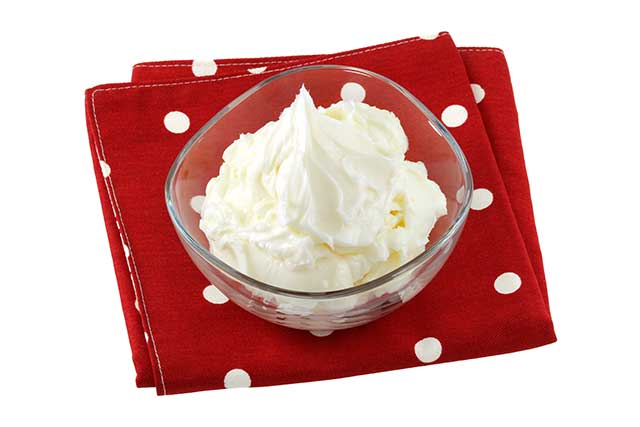
Vegetable shortening became popular in the early 20th century since it provided the same cooking properties as lard for a lower price.
Once marketed as a “healthy” choice, it was later found to cause harm due to its ‘trans fat’ (partially hydrogenated oil) content (75).
In recent times, shortening should no longer include trans fats. Shortening is a hard, white fat that somewhat resembles lard.
Per tablespoon, here is what the nutritional values of a modern vegetable shortening may look like (76):
| Name | Amount |
|---|---|
| Calories | 113 kcal |
| Carbohydrates | 0 g |
| Fat | 12.8 g |
| Saturated fat | 3.2 g |
| Monounsaturated fat | 5.27 g |
| Polyunsaturated fat | 3.6 g |
| Omega-3 fatty acids | 0.24 g |
| Omega-6 fatty acids | 3.35 g |
| Protein | 0 g |
Fatty Acid Ratios
- Saturated Fat: 26.5%
- Monounsaturated Fat: 43.7%
- Polyunsaturated Fat: 29.8%
Pros & Cons
- Modern shortening products should no longer contain trans fatty acids.
- Shortening tends to be more heat-stable than highly polyunsaturated vegetable oils. A 2018 study demonstrated that shortening had better oxidative stability than soybean oil when used for frying multiple times (77).
- Some shortening products in some countries may still contain trans fats. Check the label to ensure no “partially hydrogenated” oils are present.
Which Is the “Best” Cooking Oil?
The answer to this question is somewhat subjective and depends on the context of who is using the oil and for what.
- Common vegetable oils such as Canola, soybean, and grapeseed are all cheap and affordable. However, they are primarily a source of polyunsaturated fatty acids, which are not very heat-stable. Thus, they are not the best choice for longer periods of high-temperature cooking.
- High OLEIC varieties of vegetable oils contain more monounsaturated fat and less polyunsaturated fats. As a result, these oils are better suited to longer-duration cooking at high temperatures.
- Animal fats such as ghee, goose fat, lard, and tallow also have relatively good oxidative stability. However, these fats are high in saturated fat, which can raise LDL-C levels.
- Additionally, unrefined plant oils such as avocado, peanut, and (especially) extra virgin olive oil display excellent oxidative stability. This is partly due to their high polyphenol content.
If we focus on cooking fat’s overall health benefits rather than just heat stability, then extra virgin olive oil is probably the most evidence-based choice.
Lastly, if you’re looking for an oil for deep frying, see this guide to some of the best deep-frying oils.

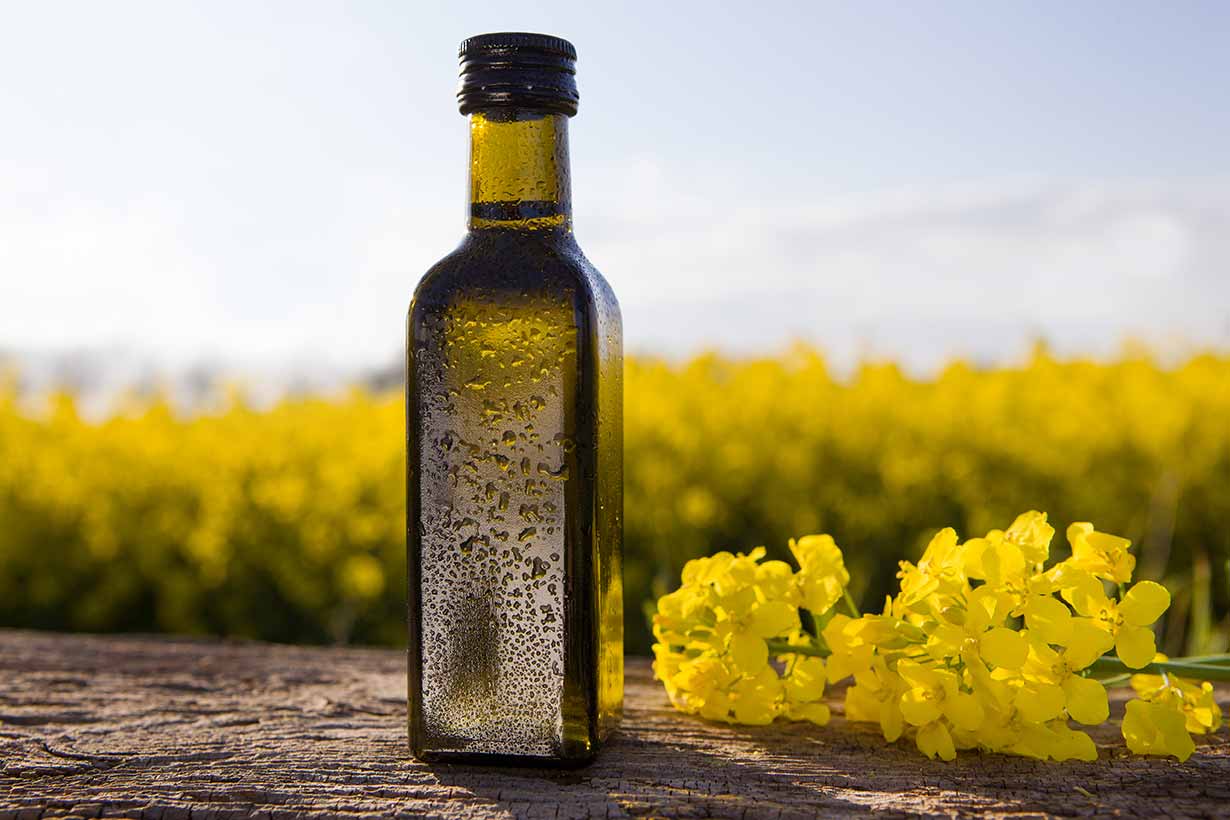

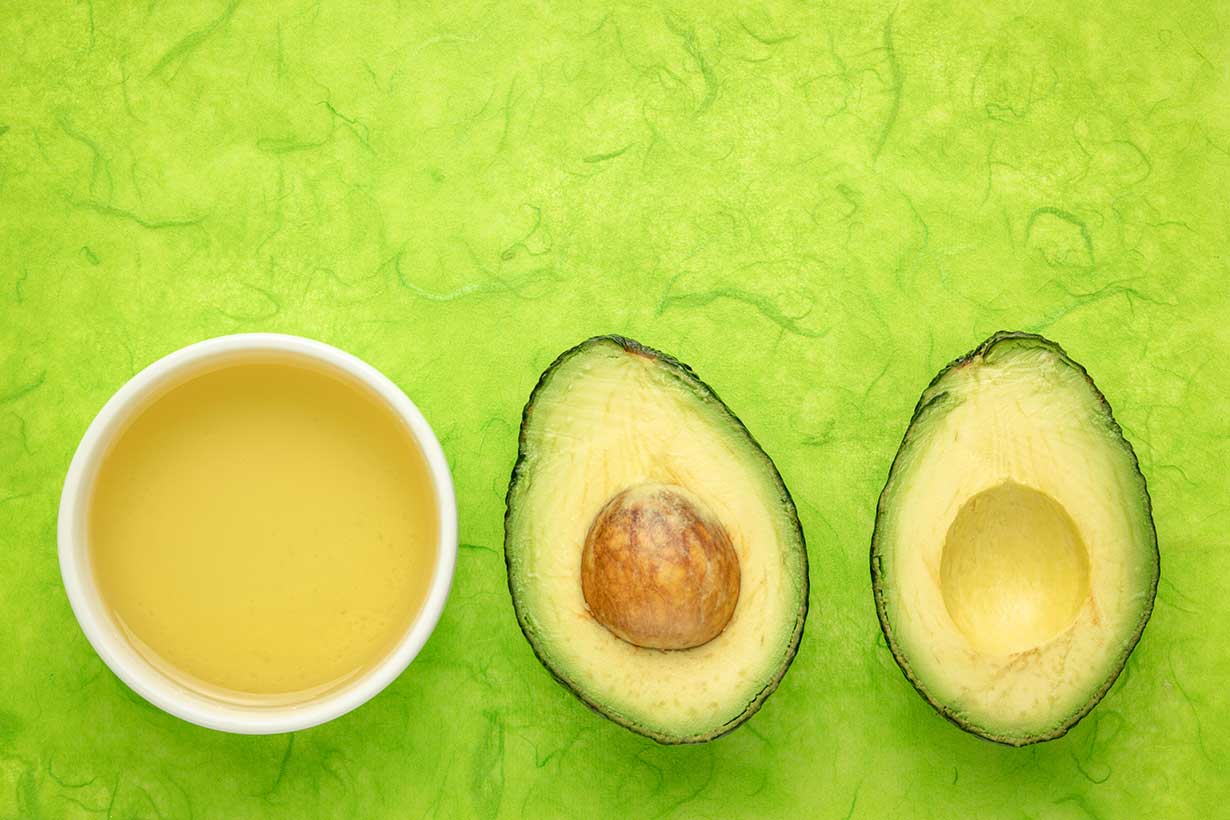


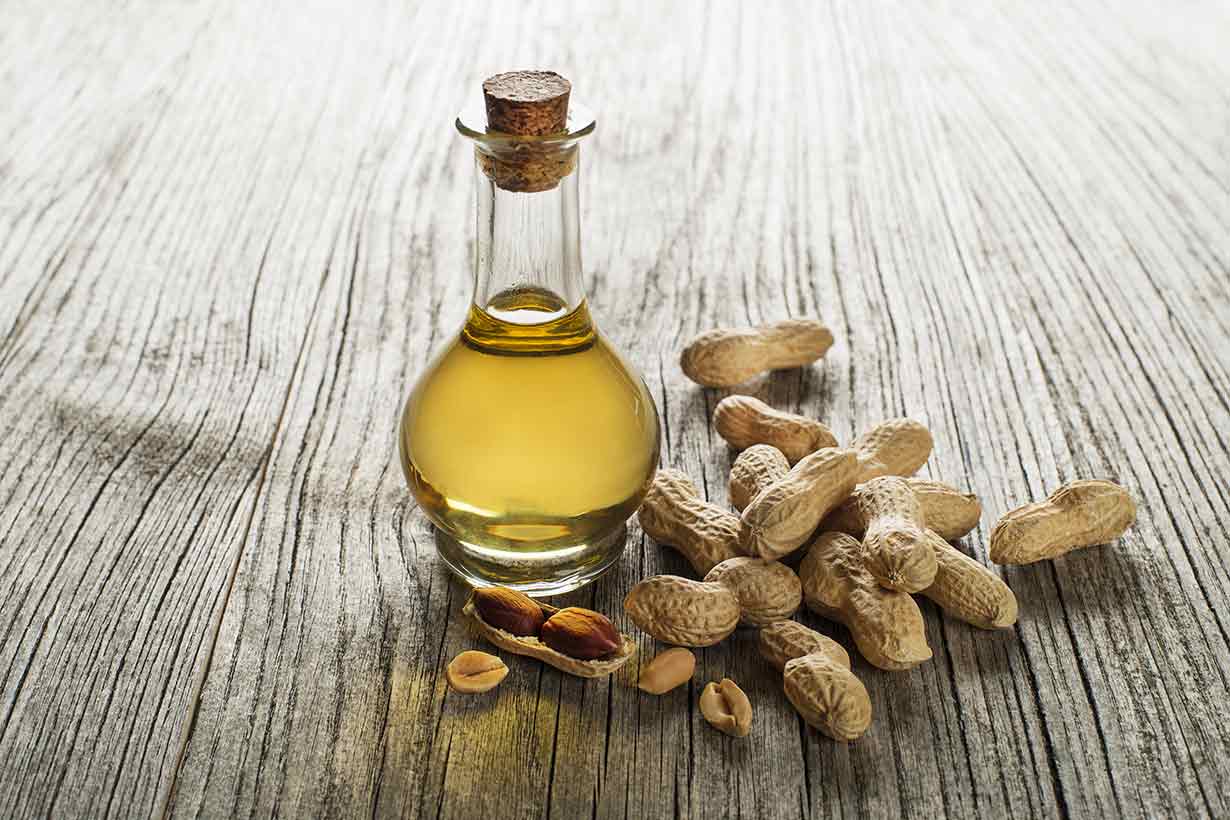

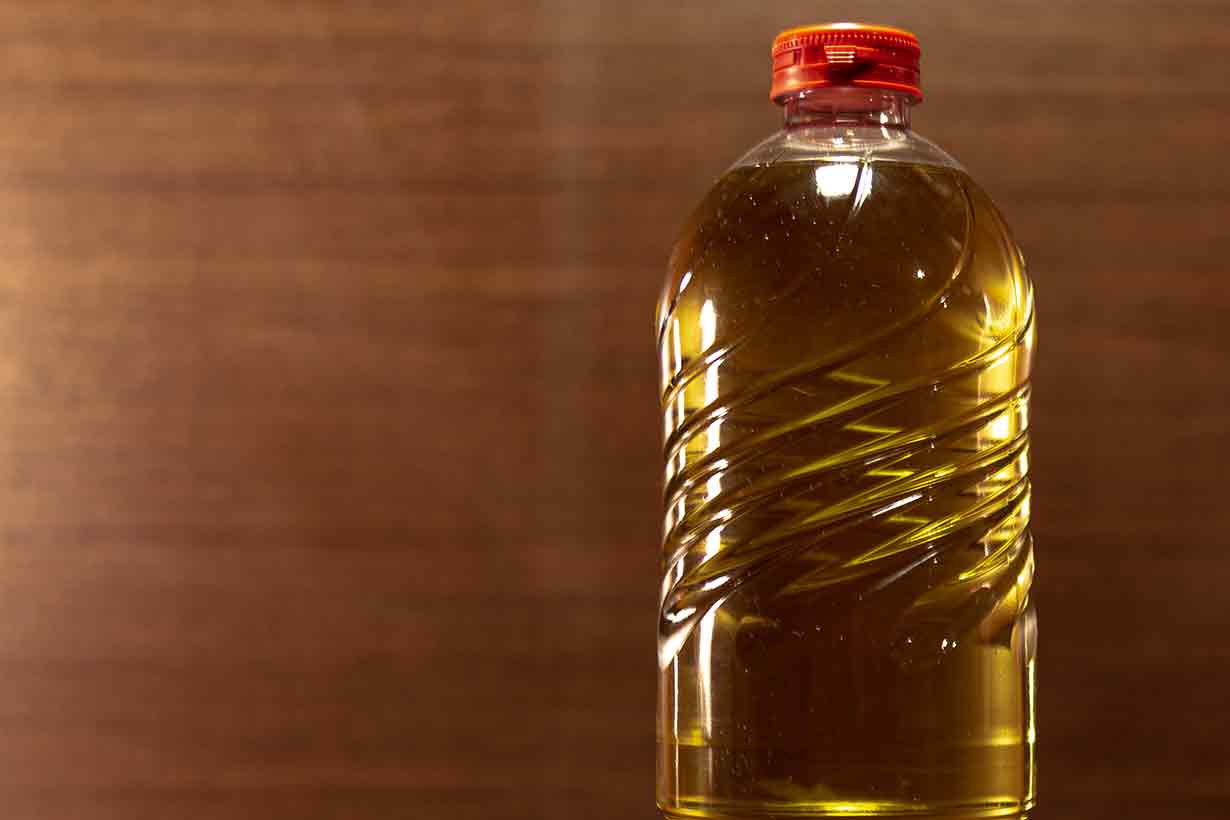
Are the seed oils inflammatory if you do not heat them? Like mayonnaise made with soybean oil or canola oil? Like in chicken salad?
Oils can be damaged by light, oxygen, and heat, so it depends on the stability of the oil and how it has been stored, transported, what kind of bottle it is in (dark glass is best) and more.
However, it seems like most of us are consuming too much omega-6 and not enough omega-3. You can see the potential issues related to this in this paper here: https://www.researchgate.net/publication/11025519_The_Importance_of_the_Ratio_of_Omega-6Omega-3_Essential_Fatty_Acids
Good informative information.
Thanks, Peter! Hope it was useful in some way.
Excellent! Thank you!
Thanks, Debby!
Micheal, Thanks for a great article. Very interesting. Nice to hear other factors than just the smoke point of a fat or oil. I’m interested in Aldehydes that are released in to food when oils are heated. Have heard that refined coconut oil creates the lowest and it has little or no taste of coconut. It’s not an oil you covered, but I’d be interested in your thoughts. Kind regards, Gulab.
Hi Gulab,
I would say that all coconut oils should tend to be the same (or at least very similar) in that regard, and I agree that they seem to generate one of the the lowest amounts of aldehydes among the plant oils.
Bear in mind that a recent independent lab test showed extra virgin olive oil to contain the fewest polar compounds though, so that may be the better option. You can read about that here (https://www.nutritionadvance.com/extra-virgin-olive-oil/) if interested.
Aldehydes also are not a big issue for the animal fats such as lard and tallow.
Thank you Micheal. I will look at that.
Hi Michael, I came upon your writing while I was searching for the best oil to include in my child’s diet. She is underweight and doctors recommend adding oil to her food to help gain some weight. I have been using EVOO mixed directly into her food but the flavour is strong. But if that is what will give the best to her health I would continue. Or is there any other oil you suggest? Your kind response is greatly appreciated. Thank you.
Hi Lukin,
EVOO is my favorite oil but you are right in that it has a strong flavor. If you are looking for an oil with a milder taste then something like avocado oil might be a good choice.
Thank you Michael! I think I’ll try that.